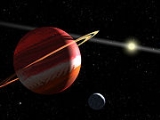
Epsilon Eridani b
Encyclopedia
Epsilon Eridani b is an unconfirmed extrasolar planet
approximately 10 light-year
s away orbiting the star Epsilon Eridani
, in the constellation
of Eridanus
(the River
).
, the discoverers gave its mass as 1.2 ± 0.33 times that of Jupiter
, with a mean distance of 3.4 AU
from the star. Observers, including Geoffrey Marcy
suggested that more information on the star's Doppler noise behaviour created by its large and varying magnetic field was needed before the planet could be confirmed. Astrometric measurements
made with the Hubble Space Telescope
also suggest the existence of the planet. These observations indicated that the planet has a mass 1.5 times that of Jupiter and shares the same plane as the outer dust disk observed around the star. However the derived orbit from these measurements is highly eccentric. This is inconsistent with the presence of an asteroid belt at roughly 3 AU from the star, discovered using observations by the Spitzer Space Telescope
: the planet would pass through the asteroid belt and rapidly clear it of material. If a giant planet does exist around Epsilon Eridani with a period similar to the one suggested by the radial velocity observations, its orbit must be nearly circular to avoid disrupting the asteroid belt.
Extrasolar planet
An extrasolar planet, or exoplanet, is a planet outside the Solar System. A total of such planets have been identified as of . It is now known that a substantial fraction of stars have planets, including perhaps half of all Sun-like stars...
approximately 10 light-year
Light-year
A light-year, also light year or lightyear is a unit of length, equal to just under 10 trillion kilometres...
s away orbiting the star Epsilon Eridani
Epsilon Eridani
Epsilon Eridani is a star in the southern constellation Eridanus, along a declination 9.46° south of the celestial equator. This allows the star to be viewed from most of the Earth's surface. At a distance of 10.5 light years , it has an apparent magnitude of 3.73...
, in the constellation
Constellation
In modern astronomy, a constellation is an internationally defined area of the celestial sphere. These areas are grouped around asterisms, patterns formed by prominent stars within apparent proximity to one another on Earth's night sky....
of Eridanus
Eridanus (constellation)
Eridanus is a constellation. It is represented as a river; its name is the Ancient Greek name for the Po River. It was one of the 48 constellations listed by the 2nd century astronomer Ptolemy, and it remains one of the 88 modern constellations. It is the sixth largest of the modern...
(the River
River
A river is a natural watercourse, usually freshwater, flowing towards an ocean, a lake, a sea, or another river. In a few cases, a river simply flows into the ground or dries up completely before reaching another body of water. Small rivers may also be called by several other names, including...
).
Discovery
The planet's existence was suspected by a Canadian team led by Bruce Campbell and Gordon Walker in the early 1990s, but their observations were not definitive enough to make a solid discovery. Its formal discovery was announced on August 7, 2000 by a team led by Artie HatzesArtie P. Hatzes
Artie P. Hatzes is an American astronomer. He is a professor at the Friedrich Schiller University of Jena and director of the Karl Schwarzschild Observatory ....
, the discoverers gave its mass as 1.2 ± 0.33 times that of Jupiter
Jupiter
Jupiter is the fifth planet from the Sun and the largest planet within the Solar System. It is a gas giant with mass one-thousandth that of the Sun but is two and a half times the mass of all the other planets in our Solar System combined. Jupiter is classified as a gas giant along with Saturn,...
, with a mean distance of 3.4 AU
Astronomical unit
An astronomical unit is a unit of length equal to about or approximately the mean Earth–Sun distance....
from the star. Observers, including Geoffrey Marcy
Geoffrey Marcy
Geoffrey W. Marcy is an American astronomer, who is currently Professor of Astronomy at the University of California, Berkeley, famous for discovering more extrasolar planets than anyone else, 70 out of the first 100 to be discovered, along with R...
suggested that more information on the star's Doppler noise behaviour created by its large and varying magnetic field was needed before the planet could be confirmed. Astrometric measurements
Astrometry
Astrometry is the branch of astronomy that involves precise measurements of the positions and movements of stars and other celestial bodies. The information obtained by astrometric measurements provides information on the kinematics and physical origin of our Solar System and our Galaxy, the Milky...
made with the Hubble Space Telescope
Hubble Space Telescope
The Hubble Space Telescope is a space telescope that was carried into orbit by a Space Shuttle in 1990 and remains in operation. A 2.4 meter aperture telescope in low Earth orbit, Hubble's four main instruments observe in the near ultraviolet, visible, and near infrared...
also suggest the existence of the planet. These observations indicated that the planet has a mass 1.5 times that of Jupiter and shares the same plane as the outer dust disk observed around the star. However the derived orbit from these measurements is highly eccentric. This is inconsistent with the presence of an asteroid belt at roughly 3 AU from the star, discovered using observations by the Spitzer Space Telescope
Spitzer Space Telescope
The Spitzer Space Telescope , formerly the Space Infrared Telescope Facility is an infrared space observatory launched in 2003...
: the planet would pass through the asteroid belt and rapidly clear it of material. If a giant planet does exist around Epsilon Eridani with a period similar to the one suggested by the radial velocity observations, its orbit must be nearly circular to avoid disrupting the asteroid belt.

